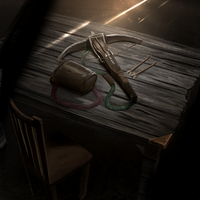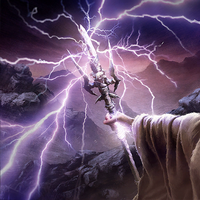Lore:Weapons
A wide variety of weapons have been wielded by warriors across Tamriel and beyond.[1][2] This section illustrates the variety of weapons used.
Weapons[edit]
Atlatl[edit]
Atlatls (also called flinging-sticks) are throwing devices employed to launch spears or darts with increased force and accuracy, in similar fashion to a slings but used for different types of projectiles.
They have applications outside of combat or hunting. Similar to slings, which find use in Orcish traditional sports, atlatls are also utilized for recreational purposes in Argonian games. In the traditional Murkwater game "The Toad Flies at Dusk," players utilize enameled flinging-sticks that terminate in shallow cups. Based on the name, these specialized flinging-sticks, also known as toad-atlatls, are likely used to launch frogs. Some of them were cherished heirlooms belonging to chieftains of Argonian tribes.
Axe[edit]
Blunt Weapons[edit]
Bow[edit]
Dagger[edit]
Crossbow[edit]
Flail[edit]
Flails are handheld weapons consisting of spiked balls or bars attached to handles by chains, typically used for striking or flailing.
They are utilized in warfare by a variety of cultures and races. This encompasses humans such as the Nords. They also find use among the Mer, including Orcs and Dwemer. Even the Daedra employ them in battle. Gargoyles are also seen wielding flails adorned with skulls integrated into their design.
Crafted in diverse styles, including Elven, Orcish, and Dwemer designs, flails are fashioned from a range of materials, spanning from common iron and steel to luxurious options such as dwarven metal, ebony, mithril, silver, and adamantium. Some are even created from daedric materials. Similar to other weapons, flails could be enchanted with a myriad of magical augmentations.
Flails served purposes beyond combat; they are utilized as instruments of torture and self-inflicted pain. Some werewolves, seeking penance for their monstrous deeds, employed silver-studded flails in ritual self-flagellation. Furthermore, specific combat practices, like the Altmeri duels governed by a code of dueling, are bound by stringent regulations. Altmeri duelists adhere to strict regulations banning the use of instruments like long swords, axes, flails, and similar weapons, in accordance with the sacred laws of Trinimac. Interestingly, some healers consider flails among their preferred weapons in melee combat. Blacksmiths and armories sometimes integrate imagery of the flail, commonly alongside the sword, on signs outside their establishments.
Garrote[edit]
Garrote is a type a weapon consisting of a piece of wire or cord used for strangling.
Garrotes are among the tools employed by the Morag Tong during their assassinations. One of the skilled practitioners of garrotes within the Morag Tong was Naryu Virian. The gear utilized by the Morag Tong is tailored specifically to their tasks and responsibilities. Notably, their gloves and gauntlets are designed for delicate work, including garroting, necessitating free finger ends for such tasks.
Katanas[edit]

Polearms[edit]
Sling[edit]
Slings are projectile weapons consisting of a strap or loop used to hurl stones or other projectiles.
Similarly to various other weapons, slings can be enchanted. The Codex Arcana, a series of compendiums compiled by the Imperial Battlemages of Battlespire, provides insight into the enchanted weapons kept within its confines. Serving as a partial index of arcane contrivances known to scholars and alchemists, it aims to familiarize all students with these artifacts to prevent their misuse or neglect. Within the compendium of enchantments lies the description of three remarkable enchanted slings: the Sling of Delight, endowed with magical healing properties; the Sling of Fickle Endowment, which invokes confusion through the destructive forces of magic; and the Sling of Riven Stars, inflicting moderate shock damage while granting its wielder insights into the mystical arts of alteration.
Slings are also used in sports, particularly in the Orcish game of Vosh Ball. Although the rules of the game evolved over time, the fundamental setup remains consistent. Two teams, each comprising six players armed with slings containing three vosh balls, vie for dominance in the enclosed court. Their objective is to incapacitate their opponents by hurling the heavy spheres with maximum force.
Staff[edit]
Staves (or staffs) are implements and weapons frequently wielded by practitioners of magic. Staves may be imbued with individual enchantments and used regardless of the wielder's magical abilities. They may also serve as focal points for casting spells to assist traditional spellcasting, acting as a focus of power rather than its source. Various types of staves can be crafted and enchanted to accommodate different forms of magic. Staves designed for casting spells exist across all schools of magic, including restoration, destruction, illusion, conjuration, alteration, thaumaturgy, or mysticism.[nb 1] Additionally, they represent a mage's status and hold considerable symbolic significance, evoking the qualities of leadership and authority.
In addition to staves, other tools serve similar purposes, such as smaller wands, which can also function as focal points for spells, or be enchanted themselves. Rods are utilized for divination, although they can also serve as tools for training in spellcasting. They also have more specific uses. Similar to staves and wands, rods can also bear singular enchantments. Some rods are designed to control fire and serve as ceremonial tools. Additionally, some are used to channel magic in similar manner to staves. The tools utilized by the Dwemer to command their animunculi are often referred to as rods.
Wands and rods are categorized as distinct implements from staves, forming part of the training equipment for Shad Astula adepts. Other types of items are also utilized as aids for channeling magic, such as gloves for members of the Psijic Order, or tomes commonly used by Arcanists.
Staves are also employed in close-quarters combat. This is often the case when spellcasters find themselves in need to fight at short range. In such scenarios, they function as blunt weapons. On occasion, they are employed for defensive purposes. Some staves possess features enabling them to function to some degree as melee weapons. Depending on their design, staves provide a diverse range of uses, doubling as half-pikes, spears, harpoons, pole-axes, or tridents when the situation demands.[nb 2] A staff can also double as a barrier when on sentry duty, or a pry bar. Some staves also serve as crosiers, often having ceremonial functions in the societies where they are used. Some staves serve as symbols of office, like the Royal Staff of Anequina, which is used by the Khajiiti monarchs of Anequina, or Fahara'jad's Rod, a royal Redguard staff. Replicas of Fahara'jad's Rod are often given as gifts by Forebear nobles to their children.
Sword[edit]
Throwing Weapons[edit]
Throwing Weapons such as throwing stars, throwing knives, darts and others are frequently used across Tamriel and beyond.
They are recognized as weapons for marksmen, renowned for their swift and rapid attacks.
Whip[edit]
See Also[edit]
- For game-specific information, see the Arena, Daggerfall, Morrowind, Skyrim, Elder Scrolls Online, Shadowkey, Battlespire, Dawnstar, Stormhold, Oblivion Mobile, Blades, and Castles articles.
- Bound Weapons
- Shehai
- Smithing
Books[edit]
- Crafting Motifs by Doctor Alfidia Lupus and Seif-ij Hidja — A series by Dr. Lupus and Seif-ij Hidja on the major cultural styles of Tamriel
References[edit]
- ^ Weapons in Morrowind, Oblivion, Skyrim, and ESO
- ^ Crafting Motifs — Doctor Alfidia Lupus and Seif-ij Hidja
|
||||||||||||||











